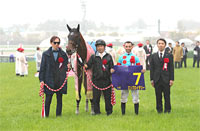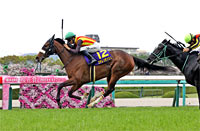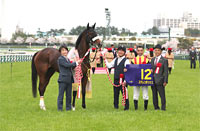Oka Sho (Japanese 1000 Guineas) (G1) - Data Analysis
Note: “1-win,” “2-win,” and “3-win” classes correspond to the previous “5 million yen-or-less,” “10 million yen-or-less,” and “16 million yen-or-less” classes.
First top-level contest for three-year-old fillies
The Oka Sho (Japanese 1000 Guineas) is a 1,600m turf race held at Hanshin Racecourse, which is also the venue for the Hanshin Juvenile Fillies (the champion decider for two-year-old fillies) and the Tulip Sho (a prep race for the Oka Sho). The Hanshin Juvenile Fillies and Tulip Sho are held under the same conditions as the Oka Sho, and runners that have finished in the Top 3 in either of these races tend to perform well in the Oka Sho. Let’s now look for some trends in results over the last 10 years.
Highly favored runners have the edge
All Top 2 finishers over the last 10 years were backed as 8th favorite or higher. Runners backed as 2nd favorite achieved Top 2 and Top 3 ratios of 70.0%. Race favorites, on the other hand, had a less impressive Top 2 ratio of 40.0% and Top 3 ratio of 50.0%. Looking at performances by win odds, we find that the five runners backed by win odds in the 1.0-1.9 range only produced one winner. Meanwhile, three of the four runners backed by win odds in the 2.0-2.9 range were beaten to 4th or lower. Conversely, all seven runners backed by win odds in the 3.0-4.9 range finished in the Top 2. [Table 1] [Table 2]
[Table 1] Performance by favoritism (last 10 years)
| Favoritism |
Performance
[1st-2nd-3rd-4th or lower] |
Win ratio |
Top 2 ratio |
Top 3 ratio |
| 1st favorite |
2-2-1-5 |
20.0% |
40.0% |
50.0% |
| 2nd favorite |
4-3-0-3 |
40.0% |
70.0% |
70.0% |
| 3rd favorite |
1-2-3-4 |
10.0% |
30.0% |
60.0% |
| 4th, 5th favorite |
1-1-2-16 |
5.0% |
10.0% |
20.0% |
| 6th-8th favorite |
2-2-2-24 |
6.7% |
13.3% |
20.0% |
| 9th favorite or lower |
0-0-2-96 |
0% |
0% |
2.0% |
[Table 2] Performance by win odds (last 10 years)
| Win odds |
Performance
[1st-2nd-3rd-4th or lower] |
Win ratio |
Top 2 ratio |
Top 3 ratio |
| 1.9 or lower |
1-1-1-2 |
20.0% |
40.0% |
60.0% |
| 2.0-2.9 |
1-0-0-3 |
25.0% |
25.0% |
25.0% |
| 3.0-4.9 |
4-3-0-0 |
57.1% |
100% |
100% |
| 5.0-9.9 |
1-2-4-9 |
6.3% |
18.8% |
43.8% |
| 10.0-19.9 |
2-2-0-18 |
9.1% |
18.2% |
18.2% |
| 20.0-29.9 |
0-2-2-16 |
0% |
10.0% |
20.0% |
| 30.0-49.9 |
1-0-2-18 |
4.8% |
4.8% |
14.3% |
| 50 or higher |
0-0-1-82 |
0% |
0% |
1.2% |
Check performance by bracket number
The Oka Sho races held over the last 10 years have consistently been contested by a field of 17 or more runners. Looking a performances of runners in these races in terms of bracket number, we observe that nine of the 10 winners and eight of the 10 runners-up started in brackets 4 or above. Similarly, eight of the 10 third-place finishers started in brackets 5 or above. In other words, runners starting in the middle or outer brackets tend to outperform those starting in the inner brackets. [Table 3]
[Table 3] Performance by bracket number (last 10 years)
| Bracket number |
Performance
[1st-2nd-3rd-4th or lower] |
Win ratio |
Top 2 ratio |
Top 3 ratio |
| 1 |
0-1-1-17 |
0% |
5.3% |
10.5% |
| 2 |
0-0-1-18 |
0% |
0% |
5.3% |
| 3 |
1-1-0-18 |
5.0% |
10.0% |
10.0% |
| 4 |
3-2-0-15 |
15.0% |
25.0% |
25.0% |
| 5 |
3-0-4-13 |
15.0% |
15.0% |
35.0% |
| 6 |
0-2-2-16 |
0% |
10.0% |
20.0% |
| 7 |
2-2-1-25 |
6.7% |
13.3% |
16.7% |
| 8 |
1-2-1-26 |
3.3% |
10.0% |
13.3% |
Strong performance by runners that contested the Tulip Sho last time out
Looking at performances by runners in terms of their previous race, we note that runners coming straight from the Tulip Sho, a 1,600m turf graded race held at Hanshin Racecourse that serves as a prep race for the Oka Sho, enjoyed success. Conversely, runners coming straight from the Hochi Hai Fillies’ Revue (another graded race positioned as a prep race for the Oka Sho) delivered only one Top 2 finisher: 2017 winner Reine Minoru. [Table 4]
[Table 4] Performance by previous race (last 10 years)
| Previous race |
Performance
[1st-2nd-3rd-4th or lower] |
Win ratio |
Top 2 ratio |
Top 3 ratio |
| G1 |
1-1-0-3 |
20.0% |
40.0% |
40.0% |
| Hochi Hai Fillies’ Revue |
1-0-2-54 |
1.8% |
1.8% |
5.3% |
| Tulip Sho |
6-6-6-26 |
13.6% |
27.3% |
40.9% |
| G3 race open to fillies and colts |
1-0-0-4 |
20.0% |
20.0% |
20.0% |
| G3 race open only to fillies |
0-3-2-28 |
0% |
9.1% |
15.2% |
| Open-class stakes |
1-0-0-31 |
3.1% |
3.1% |
3.1% |
5 million yen-or-less
(now 1-win class) |
0-0-0-2 |
0% |
0% |
0% |
Note: “G3 race open only to fillies” does not include the Tulip Sho races held through 2017.
Looking at runners that had contested the Tulip Sho in their last outing in terms of finish in that race, we find that only one runner achieved consecutive wins in the Tulip Sho and the Oka Sho (2014 winner Harp Star). However, it is worth remembering that many runners have rebounded from a defeat in the Tulip Sho to deliver a strong performance in the Oka Sho. [Table 5]
[Table 5] Among runners that had contested the Tulip Sho last time out, performance by finish in that race (last 10 years)
| Finish in the Tulip Sho |
Performance
[1st-2nd-3rd-4th or lower] |
Win ratio |
Top 2 ratio |
Top 3 ratio |
| 1st |
1-2-1-4 |
12.5% |
37.5% |
50.0% |
| 2nd |
2-1-1-6 |
20.0% |
30.0% |
40.0% |
| 3rd |
2-1-2-5 |
20.0% |
30.0% |
50.0% |
| 4th, 5th |
1-0-0-2 |
33.3% |
33.3% |
33.3% |
| 6th or lower |
0-2-2-9 |
0% |
15.4% |
30.8% |
Runners with consecutive wins in debut and second races have performed well in recent years
Looking at performances by runners in the Oka Sho races since 2014, we find that runners that had notched “consecutive wins in their debut and second race” finished in the Top 2 every year. Between 2010 and 2013, none of the runners matching this profile finished in the Top 2, so we can regard this as a recent trend. From 2015, however, runners with this track record have consistently produced one of the two Top 2 finishers, which is an interesting statistic. [Table 6]
[Table 6] List of Oka Sho Top 2 finishers with consecutive wins in debut and second races (last 10 years)
| Year |
Finish |
Horse |
Debut race |
Second race |
| 2014 |
1st |
Harp Star |
2yo newcomer |
Niigata Nisai Stakes |
| 2nd |
Red Reveur |
2yo newcomer |
Sapporo Nisai Stakes |
| 2015 |
2nd |
Culminar |
2yo newcomer |
Elfin Stakes |
| 2016 |
2nd |
Sinhalite |
2yo newcomer |
Kobai Stakes |
| 2017 |
1st |
Reine Minoru |
2yo newcomer |
Kokura Nisai Stakes |
| 2018 |
2nd |
Lucky Lilac |
2yo newcomer |
Artemis Stakes |
| 2019 |
1st |
Gran Alegria |
2yo newcomer |
Saudi Arabia Royal Cup |
Seek out the winner!
Focus on runners that have been defeated while backed as race favorite
Looking at performances by runners in the Oka Sho races over the last six years, we find that all winners had experience of “being beaten to 2nd or 3rd in a race in which they were backed as the race favorite.” Last year, seven runners with such experience entered the Oka Sho, and only two of these were backed by win odds under 10.0: winner Gran Alegria (2nd favorite) and 7th-place finisher Aile Voix (8th favorite). [Table 7]
[Table 7] Last six winners’ race in which they were beaten to 2nd or 3rd place while backed as race favorite
| Year |
Winner |
Race in question |
| 2014 |
Harp Star |
2 races back |
Hanshin Juvenile Fillies |
1st favorite |
2nd place |
| 2015 |
Let’s Go Donki |
3 races back |
Artemis Stakes |
1st favorite |
2nd place |
| 2016 |
Jeweler |
Last race |
Tulip Sho |
1st favorite |
2nd place |
| 2017 |
Reine Minoru |
Last race |
Hochi Hai Fillies’ Revue |
1st favorite |
2nd place |
| 2018 |
Almond Eye |
3 races back |
2yo newcomer |
1st favorite |
2nd place |
| 2019 |
Gran Alegria |
Last race |
Asahi Hai Futurity Stakes |
1st favorite |
3rd place |
Note: When there is more than one race in question, the most recent one is shown.
(Yasunori Asano)
|




















